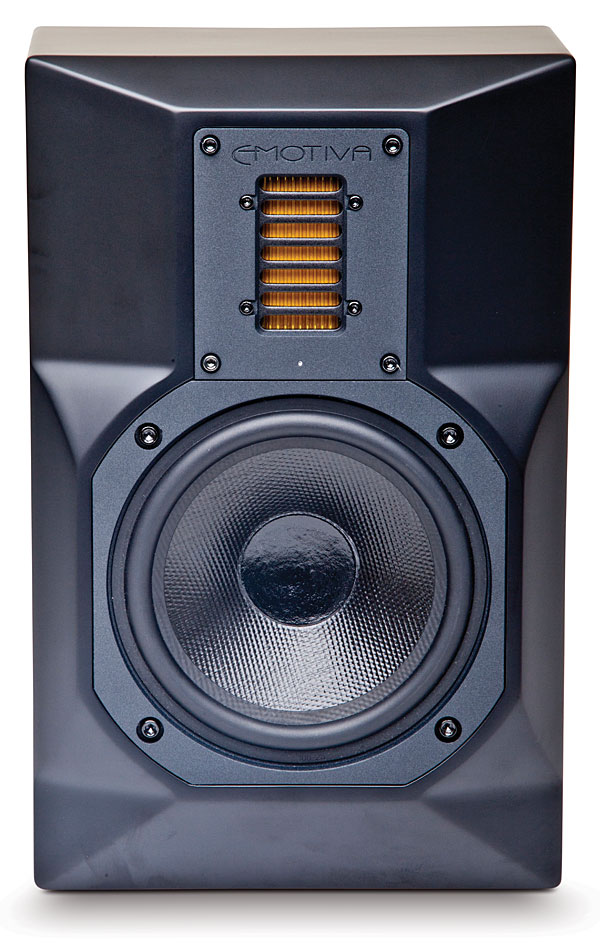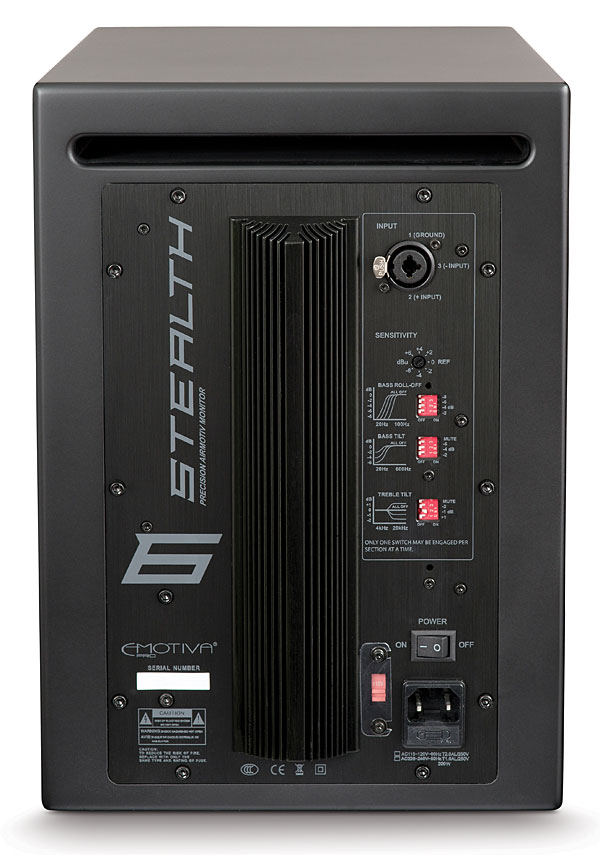I just imported a pair of Emotiva Stealth 8's. I also own two pairs of EMES Black monitors and one pair of ADAM A7X's. I am very happy with the purchase of the Emotivas and if I buy again I would probably buy Emotivas all round for my surround sound system.
Emotiva Pro Stealth 8 Speaker System

AT A GLANCE
Plus
Big sound with undistorted, low bass
Separate, built-in amplifiers for the woofer and tweeter
Controls for fine-tuning bass and treble
Rock-solid MDF cabinetry
Minus
Requires interconnects and power to each speaker
THE VERDICT
A remarkably dynamic system with solid bass, airy highs, and wide imaging—with no amplifiers needed.
At first I wasn’t sure about the prospects for reviewing Emotiva Pro’s new Stealth speakers, if only because they’re bona-fide studio monitors. But after conferring with Dan Laufman, the designer and CEO, I was eager to try them. Turns out the Stealths are easily domesticated, and since they’re internally biamplified—there’s one amp for the tweeter and another for the woofer—I didn’t need to use a receiver, power amp, or surround processor for this review. My trusty Oppo BDP-95 Blu-ray player would get the job done: It has 7.1-channel analog outputs driven by high-quality Sabre DACs, bass management, and a volume control. This time out, it’s all about maximizing performance with the minimal outlay for gear. Of course, if you don’t have an Oppo, a surround processor or an A/V receiver with multichannel analog outputs will do just as well. One thing’s for sure, though—I definitely didn’t need a power amp. The three Stealth 8s for the front left, center, and right channels, and the two Stealth 6s handling surround duties claimed a total of 1,620 watts on tap!
Pro Active
Active or self-powered speakers have a number of advantages over conventional passive speakers, starting with the fact that the designers can tailor the built-in amplifiers’ response to achieve the best possible sound from the drivers. The Emotiva amps connect directly to the drivers; they don’t have to pass the signal through a passive crossover network of resistors, capacitors, or inductors; and the designers can use equalization to maximize the woofer’s low-frequency extension. That’s no hype—there’s no way a normal passive speaker of the size of the Stealth 8 or Stealth 6 could deliver bass as low as these did at high volume without audible distortion. I’ve never heard speakers anywhere near these sizes do that before. And it’s not just that the Stealths deliver surprisingly low bass—it’s tight, dynamic, and punchy bass. Some Stealth system owners might not feel a need to add a subwoofer.

The internal amps are based on the same fully discrete Class AB designs (not Class D) used in Emotiva’s full-size, component amps like the 200-watt-per-channel XPA-3. Each Stealth 8 has one 200-watt amp for the tweeter and another 200-watt amp on the woofer. The Stealth 6 uses the same arrangement, but with a 110-watt amp on the woofer and a 100-watt amp on the tweeter.
Rather than go with a standard dome tweeter, Laufman selected an air motion transformer. We’ve seen similar tweeters recently in speakers from GoldenEar, MartinLogan, and Adam Audio. The tweeter looks like a ribbon tweeter, but instead of pushing air to make sound, the Stealth’s pleated diaphragm “squeezes” the air. The flat tweeter’s large, 60 x 32-mm radiating area requires less movement to generate a given sound pressure level than a 1-inch dome tweeter, so in theory it produces less distortion at high volume levels.
The Stealth 6 and 8 feature lightweight Curv woven polypropylene woofer cones optimized for rigidity. The drivers’ sport cast baskets and copper pole pieces. Both models use the same tweeter, but the Stealth 8 has an 8-inch woofer and the Stealth 6 has a 6.5-inch woofer.
The cabinets feature 2-inch-thick, CNC-milled MDF baffles, extensive internal bracing, and they’re finished with six coats of satin black lacquer. Both models have bass ports, wide slots that run nearly the full width of the cabinets’ rear panels, so don’t plan on placing these guys too close to a wall. Build quality and finishing standards are far beyond what I’d expect from speakers in the Stealths’ price class.
The Setup
As soon as I had the Stealths unboxed and positioned on stands, I ran into one little hurdle: The speakers don’t have RCA inputs, just a single pro-style connector that accepts a balanced XLR or a balanced or unbalanced 0.25-inch phone plug. When I queried Laufman about why he didn’t include an RCA jack, he reminded me the Stealths are pro monitors, and engineers wouldn’t take his speakers seriously if they had RCA jacks on their backsides. He suggested I pick up a set of RCA-to-0.25 adapters, and they worked perfectly. I ran long interconnect cables from the Oppo to the five Stealths. Since these speakers have built-in amps, each one also had to be plugged into an AC power outlet.

The rear panel also hosts a small rotary gain control (volume adjustment) and three sets of dip switches you can use to fine-tune the speakers’ frequency response in your room. There’s a Bass Tilt adjustment, Bass Roll-Off adjustment, and Treble Tilt adjustment. You can use a spectrum analyzer app on your phone to fine-tune the Stealths’ frequency response in your room, or do what I did: listen. I selected the –2-decibel cut on the Bass Roll-Off on the center-channel Stealth 8; since it was positioned much closer to the floor than the other Stealths, it was a bit bassier than the others. That –2-dB cut did the trick.
I started by running all the speakers as Large in the BDP-95’s setup menu, so the player wasn’t providing any bass management, and my $699 Hsu Research VTF-3 MK4 12-inch subwoofer was strictly utilized for LFE (.1). The system sounded great, but when I listened without the sub, the five Stealths did not disappoint. As noted earlier, I can imagine some owners might be perfectly satisfied running sans sub, though the VTF-3 MK4 definitely went deeper and provided a more solid foundation than the speakers could on their own. I had the sub in play for most of my listening tests, but then I wondered if there was anything to gain by going for more aggressive bass management, so I set all five speakers to Small, crossing them over to the sub at 60 hertz. A few minutes later, I had my answer: No way. The speakers sounded smaller, and when you stop and think about it, you’ll see why. Sure, low bass may be nondirectional, but with all of the under-60-Hz summed to mono in the VFT-3 MK4, the speakers lost a bit of their gravitas. No gains in dynamic oomph or volume capability were noted; the Stealths sounded better when I switched them back to Large and ran them as true full-range speakers.
- Log in or register to post comments






































































